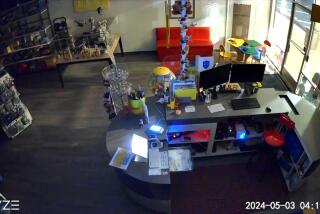Authorities Catch Suspect in Series of Identity Theft Cases
- Share via
VAN NUYS — In a rare arrest, authorities apprehended a man believed to be an identity thief who fraudulently went on shopping sprees around Los Angeles County, police said Wednesday.
Thomas M. Little, 51, allegedly bought $13,000 worth of cell phones, trendy clothing and other department store merchandise on credit before a suspicious clerk discovered he was using the identity of another man, said LAPD Det. Ken Belt.
Little, of Los Angeles, was booked Tuesday on suspicion of attempted grand theft and is being held in Van Nuys jail in lieu of $100,000 bail. Little, who was released from prison a few months ago after serving time for bank robbery, is expected to be arraigned today. He will probably face charges that include identity theft, said Belt, a supervisor of Consolidated Effort to Combat Auto Theft, or CECAT, a multi-agency unit that includes investigators from the CHP and the Department of Motor Vehicles.
Typically, identity theft crimes--which usually involve impostors using the name and Social Security number of another to fraudulently obtain credit or obtain loans--remain unsolved because they are difficult to investigate, law enforcement experts said.
Victims often don’t discover and report the crime until months or years after the impostor struck, and by that time the evidence trail has gone cold. Cooperation from different police agencies is needed to investigate crimes committed by a single thief who may operate in different jurisdictions.
The LAPD Financial Crimes Division has estimated that fewer than 1% of their identity theft cases are solved.
But in this case, a combination of luck, diligence, and quick response led to the suspect’s capture, police and the crime’s victim said.
Little was trying to buy two jet skis and a boat trailer, totaling $20,000, from Honda of North Hollywood, Belt said. To buy on credit, he allegedly used the Social Security number of another man and a phony driver’s license bearing his photo with the other man’s name.
As it turned out, the other man--Mark Nystrom of San Jose--had suspected he was an identity theft victim when he received an unsolicited credit card from a department store. Earlier this month, the 42-year-old telecommunications engineer called the three main credit reporting bureaus, Equifax, Experian and Trans Union, to put a “fraud alert” on his files to require businesses to call him before issuing new credit.
On Tuesday, the Honda of North Hollywood employee assisting Little noticed the flag on Nystrom’s file and that a lot of credit had been issued under Nystrom’s name.
When Little left the store temporarily, the employee called Nystrom’s contact number in his credit file and discovered the real Nystrom was at work hundreds of miles away, Belt said.
The employee immediately called investigators he knew from CECAT, Belt said. Police arrived promptly and arrested Little when he returned.
After Little’s arrest, police discovered he had bought, all on credit, $3,000 in cell phones through mail order and spent $5,000 at Bloomingdale’s in Century City and another $5,000 at two Banana Republic stores, one in Century City and another at the Beverly Center. Little also allegedly had put in credit applications to buy a car at dealerships in the county, investigators said.
“We caught this right at the time he was actually using the fraudulently obtained identification,” Belt said.
Because these cases are usually much more difficult to solve, prevention is key, police said.
*
Shred any document that bears your name and any identification, such as Social Security or bank account numbers, Belt said. Thieves have been known to fish through trash bins.
Make sure your mailbox is secure, Belt said, because thieves often take pre-approved credit cards or blank checks.
Finally, if you suspect you’re a victim of identity theft, notify the three credit reporting bureaus immediately and have fraud alerts put on your file, as Nystrom did.
“You think it can never happen to you,” Nystrom said. “I don’t have a clue as to how [the thief] got my information.”
More to Read
Sign up for Essential California
The most important California stories and recommendations in your inbox every morning.
You may occasionally receive promotional content from the Los Angeles Times.













